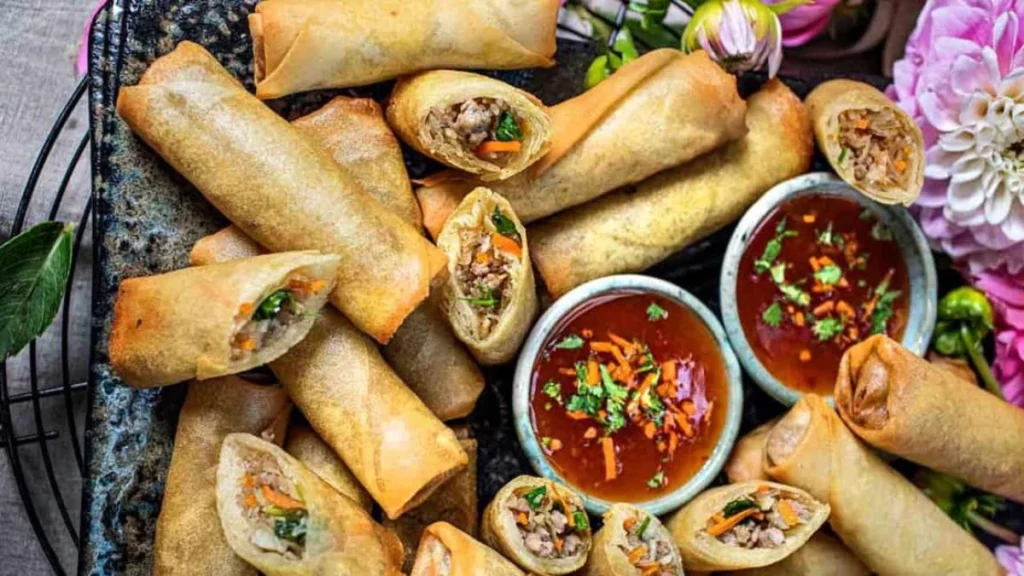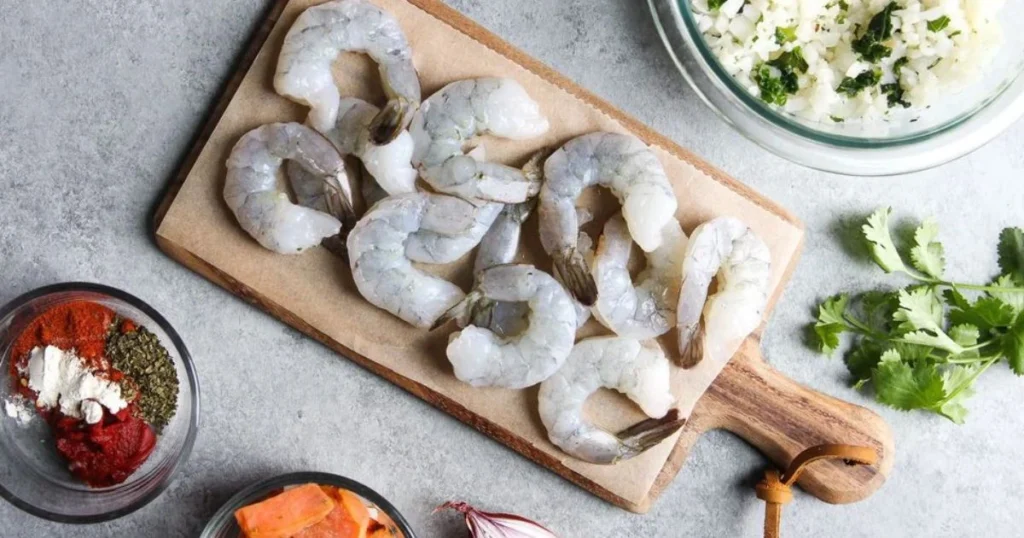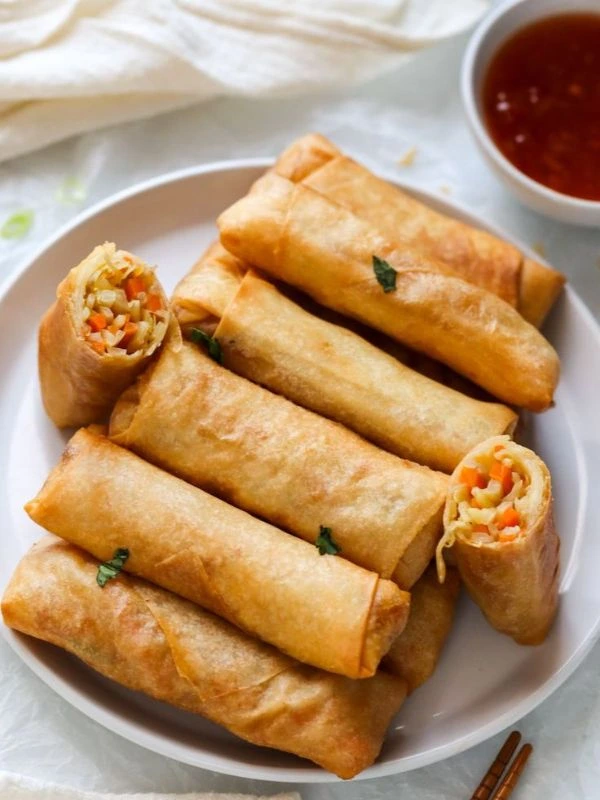Table of Contents
The Secret to Flavorful Spring Rolls
Spring rolls are a favorite appetizer in Asian cuisine. They mix crispy texture with fresh, vibrant flavors. But the real secret to making them stand out is using shrimp paste. This ingredient adds a deep, umami flavor that traditional fillings can’t match.
Shrimp paste is a key ingredient in Southeast Asian cooking. It’s made from fermented shrimp, salt, and sometimes other seasonings. Its strong aroma and savory taste can make your spring rolls taste like they’re from Asia. With the right techniques, you can make spring rolls that everyone will remember.

Key Takeaways
- Shrimp paste is a secret ingredient that can elevate the flavor of homemade spring rolls.
- Incorporating shrimp paste into your spring roll recipe adds an authentic, umami-rich taste.
- Proper techniques and understanding of shrimp paste are crucial for achieving the perfect spring roll.
- Shrimp paste can transform your spring roll experience with its pungent, savory essence.
- Mastering the use of shrimp paste in spring rolls can impress your guests and take your culinary skills to the next level.
Understanding Shrimp Paste and Its Role in Asian Cuisine
Shrimp paste is a key ingredient in Southeast Asian cooking. It brings a savory, umami flavor to many dishes. This ingredient comes from coastal areas where seafood is plentiful. It’s a big part of the cooking traditions in Thailand, Vietnam, Indonesia, and Malaysia.
Traditional Uses in Southeast Asian Cooking
In Southeast Asia, shrimp paste boosts the taste of marinades, sauces, and stir-fries. It’s loved in Thai tom yum soup, Vietnamese nuoc cham, and Indonesian sambal. It’s mixed with garlic, chilies, and lime for a rich flavor.
Different Types of Shrimp Paste Available
- Thai Shrimp Paste (Kapi): A pungent, reddish-brown paste made from fermented shrimp, salt, and sometimes chilies.
- Vietnamese Shrimp Paste (Mắm Tôm): A milder, grayish-brown paste with a subtler seafood aroma.
- Indonesian Shrimp Paste (Terasi): A dark, concentrated paste with a strong, fishy flavor.
Chemical Properties That Enhance Flavor
Shrimp paste’s flavor comes from fermentation. The process creates amino acids like glutamate, which add umami. Volatile sulfur compounds also contribute to its unique smell. This smell can make dishes taste better.
| Compound | Effect on Flavor |
|---|---|
| Glutamate | Provides a savory, umami taste |
| Sulfur Compounds | Contribute to the pungent aroma |
Essential Ingredients for Perfect Spring Rolls
Making delicious spring rolls needs the right ingredients. At the core is shrimp paste, which adds a rich, savory flavor. This ingredient makes your spring rolls truly special.
Start with quality spring roll wrappers. These thin sheets are where you create your masterpiece. Then, pick fresh veggies like shredded carrots, cabbage, and bell peppers. They add crunch and nutrition to your rolls.
For protein, use cooked shrimp or minced pork. Adding shrimp paste to the mix boosts the seafood taste. This makes your spring rolls even more delicious.
Seasoning is key to great flavor. Use garlic, ginger, and green onions for a fragrant filling. Add salt, soy sauce, and a bit of sugar for the perfect balance.
With these ingredients, you can make the best spring rolls. Improve your cooking and enjoy this Asian favorite.

Shrimp Paste in Spring Roll: A Game-Changing Addition
Shrimp paste is a secret ingredient that makes spring rolls truly special. It’s a key flavor in Southeast Asian cooking. Adding it to your spring rolls can make them unforgettable.
Proper Ratio and Mixing Techniques
To use shrimp paste right, start with a small amount. About 1-2 teaspoons per pound of filling is good. Mix it well with the other ingredients so it’s spread evenly.
Balancing Flavors With Other Ingredients
Shrimp paste packs a lot of flavor. So, balance it with fresh herbs, veggies, and proteins like chicken or shrimp. This mix of tastes and textures is what makes your spring rolls stand out.
Common Mistakes to Avoid
- Don’t overdo it with the shrimp paste. A little is enough to avoid overpowering the taste.
- Make sure to mix the shrimp paste well into the filling. This prevents any strong flavors from being too concentrated.
- Always taste your filling before making the spring rolls. Adjust the seasoning as needed to get the flavor just right.
Learning to use shrimp paste in your spring rolls can open up a new world of flavors. It’s all about finding the right balance. Your guests will love it.
Step-by-Step Spring Roll Assembly Guide
Making perfect shrimp spring rolls needs careful steps. This guide helps both experts and beginners get the right texture and look. Let’s explore the art of spring roll assembly.
First, collect all your shrimp spring roll recipe ingredients. You’ll need the wrapper, fillings, and dipping sauces. Make sure your workspace is clean and ready for assembly.
- Place a rice paper wrapper flat on your work surface. Keep it moist with a damp cloth or paper towel.
- In the wrapper’s center, put a small amount of fillings like shredded veggies, cooked shrimp, or noodles.
- Roll the bottom over the fillings, then the sides in. Roll tightly to seal the fillings.
- Wet the wrapper’s edge with water to seal the roll.
- Keep making rolls with the rest of the wrappers and fillings. You’ll have a batch of spring rolls soon.
Be gentle with the rice paper wrappers since they tear easily. Experiment with various fillings to discover your perfect shrimp spring roll flavor. Enjoy your rolls with your favorite dipping sauce.
With these easy steps, you’ll become a pro at spring roll assembly. Impress your family and friends with your culinary talents.

Best Practices for Working With Shrimp Paste
Proper handling and storage of shrimp paste are key to keeping its flavor and ensuring food safety. Shrimp paste, being quite pungent, needs extra care when adding it to your spring roll recipes.
Storage and Handling Tips
To keep shrimp paste fresh and of high quality, follow these storage tips:
- Store shrimp paste in an airtight container in the fridge. It can last up to 6 months there.
- Don’t let the paste sit in direct sunlight or heat. It will spoil faster.
- Always use a clean spoon or utensil when scooping out shrimp paste. This prevents contamination.
Measuring and Portioning Guidelines
Shrimp paste is very potent, so a small amount is enough. Here’s how to measure and portion it correctly:
- Begin with 1-2 teaspoons per recipe. Adjust to taste as needed.
- Check the flavor of your spring roll filling after adding shrimp paste. Make sure it’s balanced.
- Watch the ratio of shrimp paste to other ingredients. Too much can overwhelm the dish.
Food Safety Considerations
When using shrimp paste, food safety is paramount to avoid illness:
- Always check the expiration date and look for any spoilage signs before using.
- Clean and sanitize all surfaces, utensils, and hands before handling the paste.
- Keep shrimp paste away from other ingredients and use separate tools for it.
By following these guidelines for handling, storing, and food safety, you can bring out the best in shrimp paste. This will help you make delicious spring-rolls that will wow your guests.
Air Fryer vs. Traditional Frying Methods
Home cooks often face a choice when making spring-rolls: air fryer or traditional deep-frying? Every method comes with its own advantages and considerations.
The air fryer is popular for its ability to make crispy spring-rolls with less oil. It’s a healthier option that lets you enjoy spring-rolls without feeling guilty. The air fryer uses hot air to crisp food like deep-frying, appealing to those watching their oil intake.
Traditional deep-frying, however, is known for its authentic crunch and texture. It immerses spring-rolls in hot oil, creating a crispy outside and a tender inside. Fans of this method say it keeps the spring-rolls juicy and flavorful, just like they should be.
| Criteria | Air Fryer | Traditional Frying |
|---|---|---|
| Oil Consumption | Minimal (1-2 tbsp) | Substantial (2-3 cups) |
| Texture | Crispy exterior, slightly drier interior | Crispy exterior, moist and tender interior |
| Flavor | Lighter, more subtle taste | Richer, more pronounced flavor |
| Cooking Time | Faster (10-15 minutes) | Longer (15-20 minutes) |
| Ease of Use | Simpler, less hands-on | Requires more active monitoring |
| Health Benefits | Lower in fat and calories | Higher in fat and calories |
The choice between air frying and traditional frying for spring-rolls depends on what you prefer. It’s about your taste, dietary needs, and what you want your spring rolls to be like. Knowing the good and bad of each method helps you choose the best way to cook your spring rolls.
Complementary Dipping Sauces and Accompaniments
Take your shrimp paste-infused spring-rolls to the next level with the right dipping sauce. Try out classic Asian sauces and modern twists that will make your taste buds happy.
Classic Asian Dipping Sauce Recipes
Discover the deep flavors of Asian cuisine with these must-try dipping sauces:
- Vietnamese Nuoc Cham: A mix of sweet, sour, and savory, it’s made with fish sauce, lime juice, sugar, and chilies.
- Thai Sweet Chili Sauce: It’s a sweet, tangy, and spicy blend of sugar, vinegar, and chilies.
- Korean Gochujang Dipping Sauce: This sauce is bold and umami-rich, thanks to fermented chili paste.
Modern Fusion Sauce Options
Try these new takes on spring roll dipping sauces that mix Asian flavors with global tastes:
- Mango Chili Lime Dipping Sauce: It’s a sweet-and-sour mix that goes great with savory spring rolls.
- Peanut Butter Sriracha Dipping Sauce: The creamy peanut butter and spicy Sriracha make a great pair.
- Honey Mustard Dipping Sauce: A simple yet tasty mix of sweetness and tanginess.
Play with these spring roll dipping sauces and Asian sauce recipes to find your favorite. The world of flavors is yours to explore, so enjoy the journey.
Troubleshooting Common Spring Roll Issues
Making perfect spring-rolls is a fun cooking adventure. But, even experts can run into problems. Don’t worry, we have solutions for the most common spring roll issues.
Wrapper Woes: Preventing Tears and Cracks
Are your spring-roll wrappers always tearing or cracking? It might be because they’re not fresh or pliable. Keep them in good condition by storing them right. Before you start, make them soft again.
When you’re wrapping, press gently but not too hard. This helps avoid stretching the wrappers too much.
Leaky Fillings: Sealing the Deal
Is your filling leaking out when you fry the spring-rolls? It’s likely because you’re stuffing them too full. Spread the filling out evenly and roll the wrappers tightly.
Seal the edges with water or egg wash. This keeps your fillings inside the crispy shell.
Uneven Cooking: Mastering the Fry
Are some of your spring rolls browning too fast? It’s probably because the oil temperature is off. Keep the oil at a steady heat and flip the rolls often.
For even better results, try using an air fryer. It gives you a crispy outside without the trouble of frying on the stovetop.
By fixing these spring roll problems and using the right troubleshooting tips, you’ll soon master your spring roll recipe. Enjoy the process, try new things, and relish the tasty outcomes!
Conclusion
In this article, we’ve looked at how shrimp paste can make spring-rolls taste amazing. Shrimp paste is a key ingredient in Southeast Asian cooking. It adds a rich, savory flavor that makes food more exciting.
Learning about shrimp paste’s uses and how to use it can change your spring-roll recipes. Whether you’re a pro chef or just starting out, these tips can help you get the flavors right. Shrimp paste can also be used in many other Asian dishes.
Trying new things in the kitchen is fun, and shrimp paste is a great ingredient to explore. With a bit of practice, you can make spring-rolls that look great and taste even better. So, get creative and enjoy the tasty results.
FAQ
How does shrimp paste enhance spring-rolls?
Shrimp paste is a key ingredient in spring-rolls. It adds an authentic Asian taste. It makes the filling savory and umami-rich.
What varieties of shrimp paste are available?
There are many types of shrimp paste. Each has its own taste. You can find Thai, Vietnamese, and Indonesian terasi shrimp paste.
How do I properly incorporate shrimp paste into my spring roll filling?
Start with a small amount of shrimp paste, about 1-2 teaspoons per pound of filling. Mix it well with the other ingredients. This way, the flavor is evenly distributed.
What are some common mistakes to avoid when using shrimp paste in spring-rolls?
Avoid using too much shrimp paste. It can overpower the other flavors. Also, make sure to mix it well and store it properly to keep it fresh.
What are the benefits of air frying spring-rolls compared to traditional deep-frying?
Air frying is healthier than deep-frying. It uses less oil and makes the rolls crispy without being greasy. It’s also quicker and easier to do.
What are some delicious dipping sauces that pair well with shrimp paste-infused spring-rolls?
Try nuoc cham, sweet chili sauce, or peanut sauce with shrimp paste spring rolls. You can also make fusion sauces like mango-lime salsa or spicy sriracha mayo.
How can I troubleshoot common issues when making spring rolls?
For torn wrappers or leaky fillings, make sure your wrappers are moist. Don’t overstuff the rolls. Adjust your cooking time and temperature for the best results.
